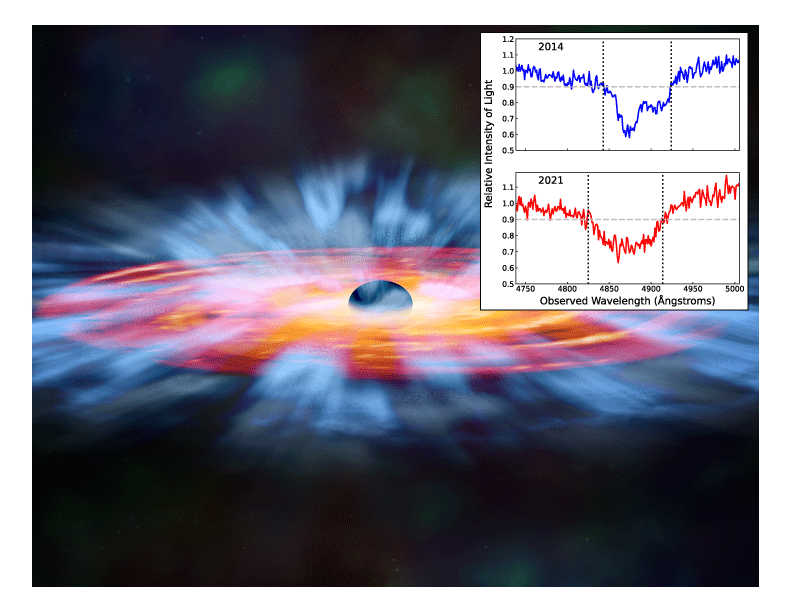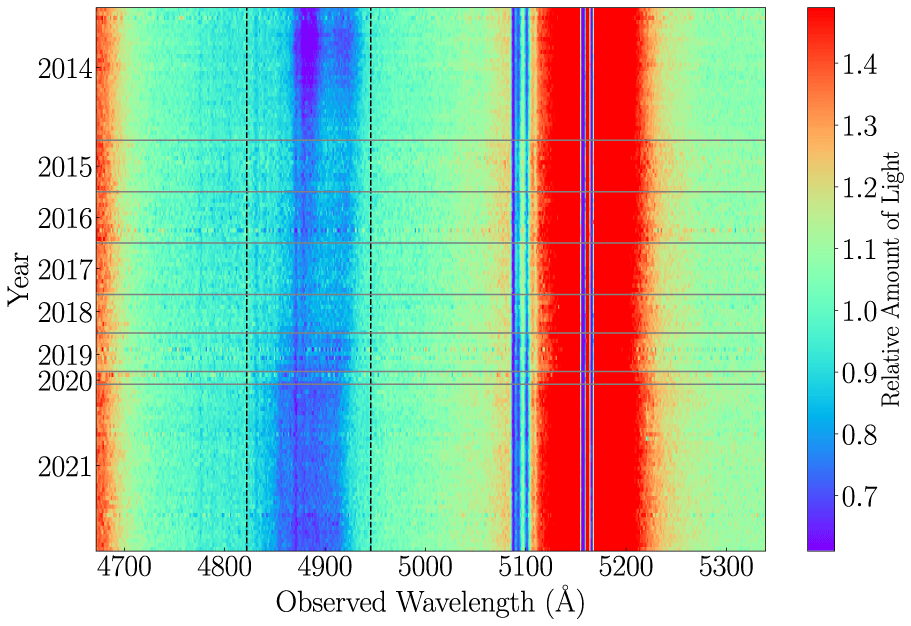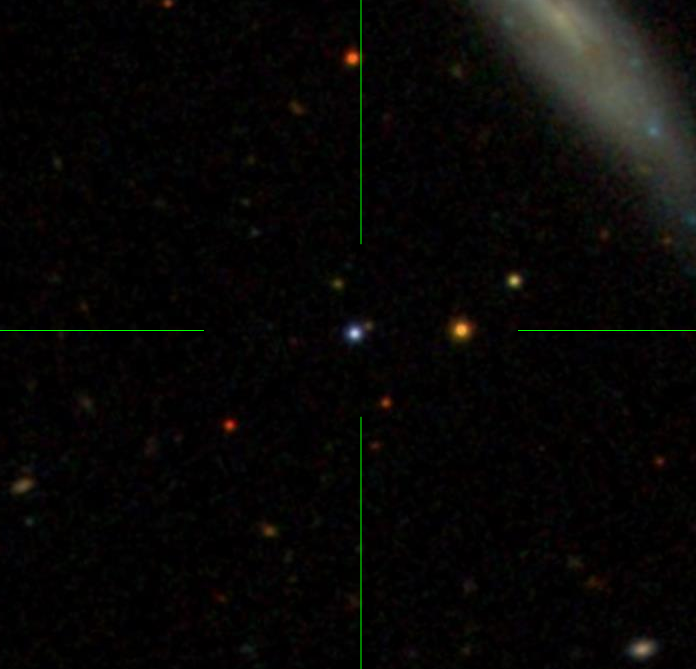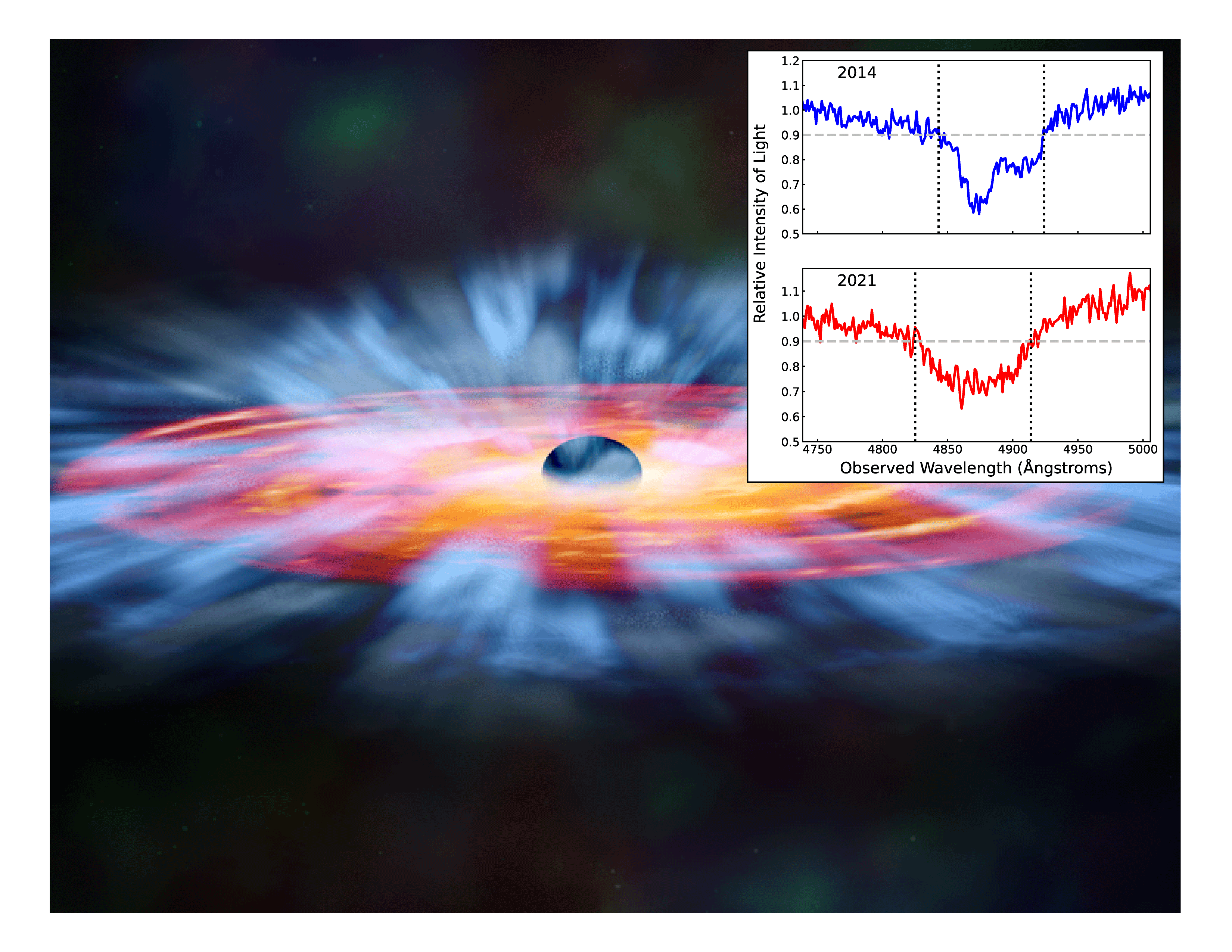A team of astronomers from the Sloan Digital Sky Survey (SDSS) has used eight years of careful, constant observations to discover unexpected changes in the winds surrounding a distant black hole.

The inset at the top right shows two spectra from the quasar SBS 1408+544, focused on the broad CIV absorption line that was the topic of this study; the top panel shows a spectrum taken in 2014, and the bottom spectrum was observed in 2021. The vertical dotted lines indicate the upper and lower boundaries of the absorption feature, which are defined by the line where the intensity equals 0.9 on each side. The observed acceleration can be seen as a horizontal shift in the absorption feature and its upper/lower boundaries.
Click on the image for a larger version.
Image Credit: NASA/CXC/M. Weiss; Catherine Grier and the SDSS collaboration
Their work, presented at the American Astronomical Society (AAS) meeting in Madison, Wisconsin, reveals that the winds surrounding the supermassive black hole at the center of the quasar known as SBS 1408+544 have begun to speed up.
“We would have never determined this was acceleration if we hadn’t had eight years of data to work with,” said Robert Wheatley, a recent graduate from the University of Wisconsin-Madison and the lead author of the paper. “Previous studies looking at quasar winds just didn’t have the data to make such detailed measurements.”
Supermassive black holes (SMBHs) reside in the centers of most (if not all) massive galaxies across the Universe; we observe them by watching the material surrounding them become overwhelmed by their strong gravitational pulls. The material that wanders too close to a SMBH gets pulled in, forming an “accretion disk” of swirling gas and dust on its way to being devoured by the black hole. If the SMBH has a constant supply of new material to consume, the disk remains in a steady state, and the material within it heats up to very high temperatures, emitting light across the entire electromagnetic spectrum. We call these SMBHs “active”, and the most luminous ones are referred to as quasars; the accretion disks in quasars are so luminous that we can observe them out to billions of light-years away.

The accelerating BAL appears between the vertical black dashed lines, which are provided to guide the eye; at the top of the plot (earlier times), the blue absorption trough lies against the right edge of the dashed line, but as we move downward (and forward in time), the blue feature shifts to smaller wavelengths, which correspond to higher velocities.
Click on the image for a larger version.
Image Credit: Robert Wheatley, Catherine Grier and the SDSS collaboration
Astronomers study quasars to learn about SMBHs in general, and to probe the Universe when it was very young. The light coming from quasars is variable, fluctuating in brightness over time. These fluctuations can be used to learn about the physical environment very close to the SMBH itself.
To study quasars, astronomers look at their spectra, which is a measure of how much light the quasar gives off at each wavelength – from ultraviolet through the full visible spectrum from blue to red, and into infrared. A spectrum can reveal far more about a quasar than a simple telescope image – so by repeatedly measuring spectra over many years, astronomers can watch quasar light fluctuations and learn about the motion of the gas in the accretion disk, which can be used to determine the mass of the SMBH.
To learn about SMBHs in great detail, the SDSS-V collaboration has been repeatedly observing thousands of quasars as part of its Black Hole Mapper (BHM) program. The SDSS is observing roughly 1800 quasars as a part of a high-cadence monitoring project — obtaining more than 100 spectra of each quasar over the course of several years. In addition to the current observations, almost 500 of these quasars have been observed as a part of a previous SDSS program called the Sloan Digital Sky Survey Reverberation Mapping Project; these quasars have been monitored by SDSS since 2014, and team members have already amassed more than 150 spectra of these quasars over the course of these 10 years.
“This kind of dataset is unprecedented,” said Catherine Grier, an Assistant Professor of Astronomy at the University of Wisconsin-Madison and Wheatley’s research supervisor for this work. “We have hundreds of spectral observations each for thousands of quasars, which allows us to study quasar variability on both long and short timescales in a very large quasar sample.”
Many of the quasar spectra in the sample show evidence for what astronomers call “Broad Absorption Line (BAL) regions,” which are produced by winds launched off the quasar accretion disk itself. These winds are carried away with enormous amounts of energy, and can potentially have a strong effect on the galaxy the quasar lives in by regulating star formation in its surroundings.

Image Credit: Jordan Raddick and the SDSS collaboration
Wheatley, Grier and their colleagues have been investigating many of these quasars that have been observed with SDSS since 2014, a few of which have been the subject of previous investigations. In 2015, Grier and colleagues studied a quasar known as SBS 1408+544, located in the constellation Boötes, which showed signs of unusually fast-changing winds. However, that study included only one year of SDSS data – enough to recognize the quasar as changing, but not enough to learn how it was changing.
Years later, Grier and her team revisited this quasar, now with 8 years of monitoring and more than 130 spectra in hand, and were surprised to discover that not only was the BAL variable in strength, but that it was shifting to higher velocities — this gas outflow was accelerating!
“The wind was already moving incredibly fast — more than ten thousand miles per second, and we’ve found that it’s only getting faster,” Wheatley said.
Contacts
Catherine Grier
University of Wisconsin—Madison
+1 (608) 265-6945
kate.grier@astro.wisc.edu
Robert Wheatley
University of Wisconsin—Madison
rwheatleyofficial@gmail.com
Keith Hawkins
Scientific Spokesperson, SDSS-V
University of Texas
+1 (512) 471-1309
keithhawkins@utexas.edu
Quasar winds are thought to be produced by strong radiation from the accretion disk blasting gas off of it. If this theory is correct, we would expect to observe acceleration in BALs as the winds are launched. However, as Wheatley noted, observations of acceleration are extremely rare because it is incredibly difficult to disentangle acceleration signatures from more typical variability in strength and shape of the absorption line. The team’s work implies that BALs may be accelerating far more often than we thought.
“There have been a few other reports of possible acceleration, but most other studies only had a handful of observations spread over several years, and it’s really hard to tell for sure whether you are seeing real acceleration,” Grier said. “We now have very solid evidence for acceleration, which we can use to refine our theories for how these winds are produced.”
This work will inform theorists who are working on theories of quasar wind production, which are important for understanding interactions between quasar winds and the galaxies that they live in, and for general studies of galaxy evolution. This work was published today in the Astrophysical Journal (Wheatley et al. 2024, Volume 968, Issue 2, Article #9; DOI: 10.3847/1538-4357/ad429e). Grier and the SDSS-V Black Hole Mapper team will continue to investigate the hundreds of BAL quasars observed by the BHM program over the next few years as they continue to monitor these incredible objects.
About the SDSS
Funding for the Sloan Digital Sky Survey V has been provided by the Alfred P. Sloan Foundation, the Heising-Simons Foundation, the National Science Foundation, and the Participating Institutions. SDSS acknowledges support and resources from the Center for High-Performance Computing at the University of Utah. SDSS telescopes are located at Apache Point Observatory, funded by the Astrophysical Research Consortium and operated by New Mexico State University, and at Las Campanas Observatory, operated by the Carnegie Institution for Science. The SDSS web site is www.sdss.org.
SDSS is managed by the Astrophysical Research Consortium for the Participating Institutions of the SDSS Collaboration, including Caltech, the Carnegie Institution for Science, Chilean National Time Allocation Committee (CNTAC) ratified researchers, The Flatiron Institute, the Gotham Participation Group, Harvard University, Heidelberg University, The Johns Hopkins University, L’Ecole polytechnique fédérale de Lausanne (EPFL), Leibniz-Institut für Astrophysik Potsdam (AIP), Max-Planck-Institut für Astronomie (MPIA Heidelberg), Max-Planck-Institut für Extraterrestrische Physik (MPE), Nanjing University, National Astronomical Observatories of China (NAOC), New Mexico State University, The Ohio State University, Pennsylvania State University, Smithsonian Astrophysical Observatory, Space Telescope Science Institute (STScI), the Stellar Astrophysics Participation Group, Universidad Nacional Autónoma de México, University of Arizona, University of Colorado Boulder, University of Illinois at Urbana-Champaign, University of Toronto, University of Utah, University of Virginia, Yale University, and Yunnan University.

